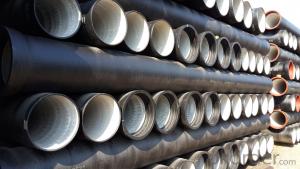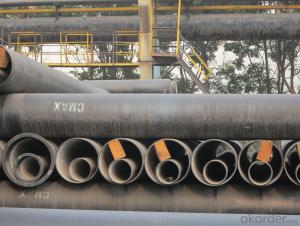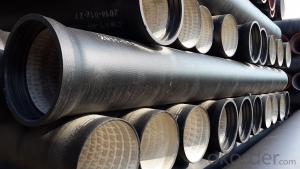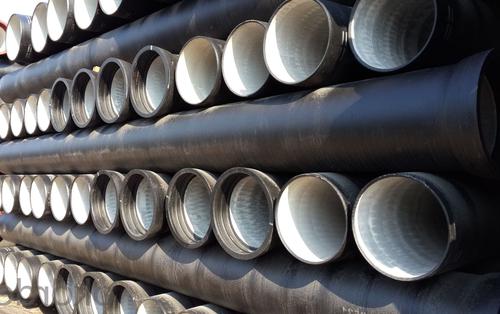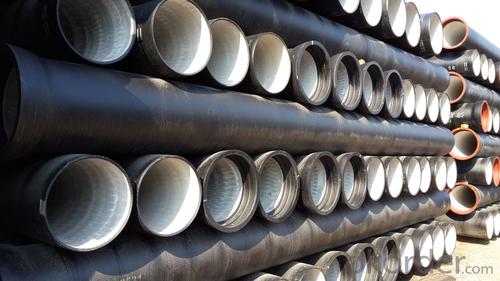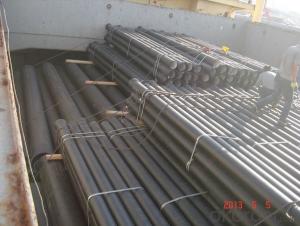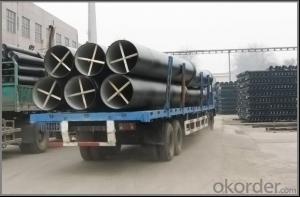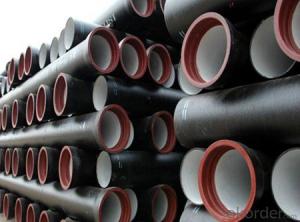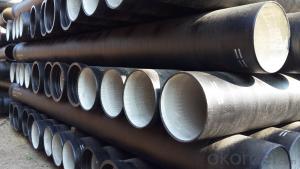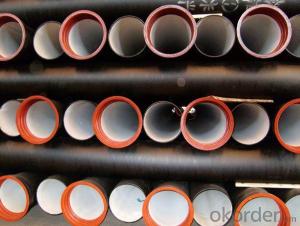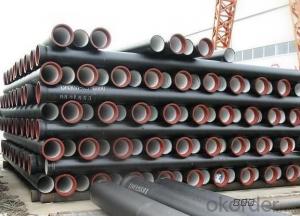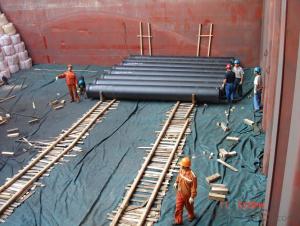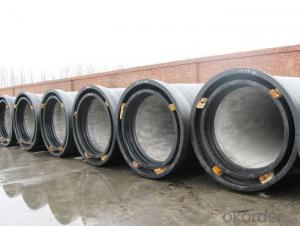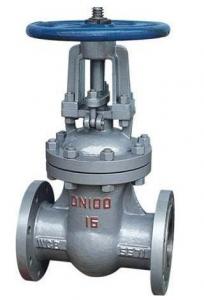Ductile Iron Pipe of China DN200-DN400 EN545/ EN598/ ISO2531
- Loading Port:
- China main port
- Payment Terms:
- TT or LC
- Min Order Qty:
- 20 m.t.
- Supply Capability:
- 50000 m.t./month
OKorder Service Pledge
OKorder Financial Service
You Might Also Like
1. Ductile Iron Pipe Description :
1) Pipes confirm to ISO2531,K9 class,T type joint,6m long,with inside cements lining conform to ISO4179, outside Zinc spraying(130g/m2) and bitumen coating(70μm) conform to ISO8179.
2) Pipe ends: Spigot and socket ends, with 100% SBR rubber gaskets accoding to ISO4633
3) We can do third party inspection according to customer's request.
4) Our products have been sold to many international market,such as Middle East and South East Asia and Africa.
2. Main Features of the Ductile Iron Pipe:
·High yield strength
·High tensile Strength
·High corrosion resistance
·Pressure Resistence
·Anti-corrosion
·Installation is convenient
·Satisfy the highest hygienic standards
3. Ductile Iron Pipe Images:
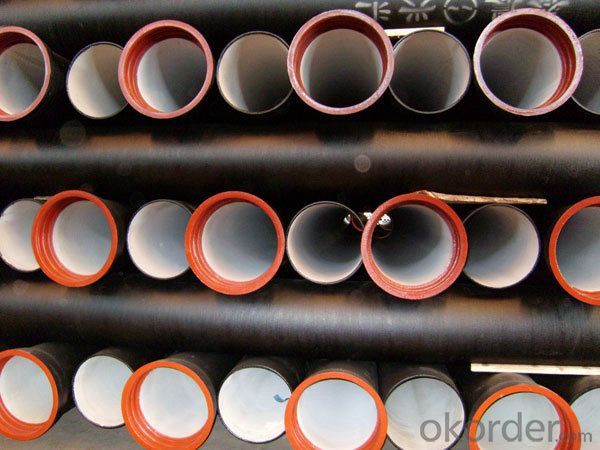
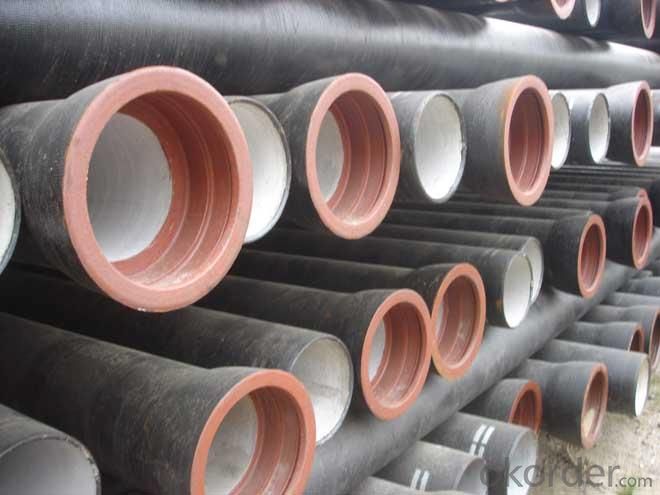
4. Ductile Iron Pipe Specification
Standard: API SPEC 5L 44th eidtion,ASTM A252-98(2007)
Grade: A53 Grades A/B, ASTM A106 Grades B/C,ASTM A179
AWWA, C200, ASTM A139, ASTM A120, API 5L Grade B
X42, X52, X56, X60, X65, X70, X80, X100
Weld Alternatives: LSAW
OD size range: 6.4~44.5mm
Wall thickness: 406.4~1422mm
Length: 3 - 12 m according to requirment
Note: Other grade can also be provided after consulting. Special design are available
for coal slurry conveyance LSAW line tube -- Service.
5. FAQ:
We have organized several common questions for our clients,may help you sincerely:
1).Q: Why would you choose ductile iron pipe rather than other pipe materials?
A:The reasons are obvious for that not only ductile iron pipe possesses the inherent strength and flexibility of ductile iron, combined with proven corrosion protection systems, but also the cost savings can be achieved from design to installation and commissioning.
2).Q:Why can you guarantee the inner of pipes can’t be corroded?
A: High alumina cement mortar lining and sulphate-resistant cement mortar lining. These two special linings are applicable to inner anti-corrosion for sewage pipes, improving resistance to erosion of the sewage components.
- Q: What is the relationship between continuous cast iron pipe and ductile iron pipe?
- Continuous cast iron pipes are usually grey cast iron pipes. Its tensile strength and elongation are much lower than those of nodular cast iron. In chemical composition, grey cast iron has less carbon content than nodular cast iron. According to the organization, the graphite form of gray iron is flaky, and the graphite form in spheroidal graphite cast iron is spherical.
- Q: Can ductile iron pipes be used in seismic zones?
- Indeed, in seismic zones, ductile iron pipes are suitable for use. These pipes possess remarkable strength and flexibility, enabling them to endure ground movement and seismic events. Their capacity to absorb and disperse the forces generated by earthquakes reduces the likelihood of pipe failure or harm. Moreover, ductile iron pipes have been effectively employed in seismic zones for numerous years, with their performance confirmed by various examinations and assessments. Nevertheless, adhering to the proper design and installation guidelines is crucial to guarantee the optimal operation and safety of ductile iron pipes in seismic zones.
- Q: What are the common methods for leak detection in ductile iron pipes?
- There are several common methods for leak detection in ductile iron pipes. These methods are widely used by professionals in the field to identify and locate leaks in a timely manner. 1. Acoustic Leak Detection: This method involves using specialized equipment to listen for the sound of water escaping from the pipe. The equipment detects the sound of the leak and helps pinpoint its location. This method is effective for both pressurized and non-pressurized pipes. 2. Visual Inspection: Visual inspection involves physically inspecting the pipe system for any visible signs of leaks such as water stains, wet spots, or puddles. This method is relatively simple and can be effective for detecting visible leaks in accessible areas. 3. Pressure Testing: Pressure testing involves pressurizing the pipe system and monitoring for any drops in pressure. If there is a leak, the pressure will drop, indicating its presence. This method is commonly used during installation or maintenance and can help identify leaks in inaccessible areas. 4. Infrared Thermography: Infrared cameras are used to detect leaks by measuring temperature differences. Water escaping from a pipe can create a temperature difference, which can be detected by the camera. This method is particularly effective for identifying hidden leaks behind walls or underground. 5. Tracer Gas Testing: Tracer gas testing involves injecting a specific gas, such as helium or hydrogen, into the pipe system. If there is a leak, the gas will escape and can be detected using specialized equipment. This method is highly sensitive and can locate even small leaks. 6. Soil Gas Monitoring: This method involves monitoring the soil around the pipe for the presence of gases emitted by leaking water. By analyzing the soil gas composition, professionals can determine the location of the leak. It is important to note that the choice of method may vary depending on the specific circumstances, such as the size of the pipe system, accessibility, and severity of the leak. In some cases, a combination of methods may be used to ensure accurate and comprehensive leak detection.
- Q: Can ductile iron pipe be used for geothermal heat exchange systems?
- Indeed, geothermal heat exchange systems can utilize ductile iron pipe. Renowned for its robustness and resilience, ductile iron pipe is perfectly suited to withstand the elevated temperatures and pressures typically found in such systems. Moreover, its exceptional resistance to corrosion is of utmost importance in geothermal applications, where minerals and chemicals present in the earth can induce corrosion. Additionally, the commendable thermal conductivity of ductile iron pipe facilitates efficient heat transfer within geothermal systems. In conclusion, ductile iron pipe stands as a dependable and economical option for geothermal heat exchange systems.
- Q: Qianwei County ductile iron pipe which tool to use cutting convenience?
- Cutting the ductile iron pipe by grinding is grinding and cutting the ductile iron tube continuously by grinding wheel until it breaks. To cut ductile iron pipes by grinding cutting method, the cutting parts should be crossed at first so as to avoid deviation during cutting. Place the drawn ductile iron tube in the cutting machine and fix the ductile iron tube and clamp it with a built-in clamp. Next, start the cutting machine and gradually press the handle of the cutting machine. The grinding wheel cuts into the ductile iron tube until the ductile iron pipe is cut off. When exerting pressure on the handle, do not force too hard at once, otherwise it will cause the grinding wheel to break. In the operation of the machine, the operator must not stand on the side of the grinding wheel, so as to avoid accidents. When the wheel appears in cutting, vibration, shaking, uneven phenomenon, should immediately stop the operation, check whether there is the wheel gap, if damaged, must be promptly replaced, to ensure safety and normal. Good cutting ductile cast iron pipe section, if there is to prevent the use of burrs, can be removed by grinding or machining file.
- Q: Can ductile iron pipe be used for wastewater treatment plant sludge handling?
- Yes, ductile iron pipe can be used for wastewater treatment plant sludge handling. Ductile iron pipe is a strong and durable material that is resistant to corrosion and can withstand the harsh conditions associated with sludge handling. It is commonly used in wastewater treatment plants for conveying sludge, as it provides excellent structural integrity and has a long service life. Additionally, ductile iron pipe is easy to install and maintain, making it a practical choice for sludge handling applications in wastewater treatment plants.
- Q: Are ductile iron pipes suitable for acidic or alkaline environments?
- Ductile iron pipes are generally suitable for both acidic and alkaline environments, although their performance may vary depending on the specific conditions. Ductile iron is a type of cast iron that has been treated with a small amount of magnesium to enhance its strength and flexibility. This treatment allows ductile iron pipes to withstand a wide range of conditions, including those found in acidic or alkaline environments. In acidic environments, ductile iron pipes provide good resistance to corrosion. The iron in the pipes reacts with the acid to form a protective layer of iron oxide, which helps prevent further corrosion. However, it is important to note that the performance of ductile iron pipes in acidic environments can be influenced by factors such as the concentration of the acid and the temperature. In highly concentrated or extremely acidic conditions, alternative materials like stainless steel or corrosion-resistant alloys may be more suitable. Similarly, in alkaline environments, ductile iron pipes exhibit good resistance to corrosion. The alkaline conditions in these environments typically help to passivate the surface of the iron, forming a protective layer that prevents further corrosion. However, as in acidic environments, the specific conditions and concentrations of alkalis may impact the performance of ductile iron pipes. In cases of very high alkalinity or extreme temperatures, other materials like plastic or concrete pipes may be more appropriate. It is worth noting that although ductile iron pipes are generally suitable for both acidic and alkaline environments, regular maintenance and monitoring are crucial to ensure their long-term performance. Proper attention should be given to monitoring the pH levels and other chemical characteristics of the environment to identify any potential issues or required maintenance. Consulting with experts or engineers in the field can provide valuable insights and guidance in selecting the most appropriate materials for specific acidic or alkaline environments.
- Q: How do ductile iron pipes handle differential settlement?
- Ductile iron pipes possess exceptional durability and are renowned for their ability to endure diverse environmental conditions, including differential settlement. Differential settlement refers to the uneven settling of the ground, which can often impose stress and strain on underground pipes. Specifically engineered to address settlement issues, ductile iron pipes exhibit inherent flexibility and strength. These pipes possess the capacity to flex and accommodate slight ground movements without incurring significant damage or failure. The flexibility of ductile iron pipes enables them to evenly distribute the stress and strain caused by differential settlement along their length. This characteristic assists in averting concentrated stress points that could potentially result in cracks or fractures in the pipe. Furthermore, the inherent strength of ductile iron pipes equips them with the necessary resistance to withstand the forces generated by differential settlement. The pipes' robust construction and high tensile strength render them less susceptible to deformation or damage caused by ground movements. Moreover, ductile iron pipes are commonly installed with flexible joints, such as rubber gaskets or push-on joints. These joints permit some movement and adapt to any slight misalignment or settlement that may occur. By providing flexibility at the joints, the pipes can better adjust to changes in ground conditions and diminish the risk of failure. In conclusion, ductile iron pipes possess the necessary attributes to effectively cope with differential settlement due to their flexibility, strength, and utilization of flexible joints. These features guarantee that the pipes can endure ground movements and continue to function efficiently without compromising their integrity or longevity.
- Q: Are ductile iron pipes suitable for installation in areas with high groundwater contamination and soil erosion?
- Yes, ductile iron pipes are suitable for installation in areas with high groundwater contamination and soil erosion. Ductile iron pipes are known for their durability and resistance to corrosion, making them highly suitable for such conditions. Additionally, their ability to withstand external pressure and soil movement makes them a reliable choice in areas prone to soil erosion.
- Q: Are ductile iron pipes resistant to frost heave?
- Generally considered resistant to frost heave, ductile iron pipes can withstand the expansion and lifting of surrounding soil caused by freezing water in the ground. Their high tensile strength and flexibility prevent cracking or breaking under the forces exerted by frost heave. Moreover, ductile iron pipes have a high resistance to impact and can handle significant external loads, making them ideal for areas with freezing temperatures and potential frost heave. Additionally, the joints in these pipes are designed to tightly seal and prevent water infiltration, reducing the risk of freezing and subsequent frost heave. However, it is important to note that while ductile iron pipes are resistant to frost heave, they are not completely immune. Extreme temperature fluctuations, prolonged freezing conditions, or inadequate insulation can still jeopardize their integrity. Therefore, proper installation techniques, including using appropriate bedding and backfilling materials, thermal insulation, and regular maintenance, are crucial to ensure long-term performance and resistance to frost heave.
Send your message to us
Ductile Iron Pipe of China DN200-DN400 EN545/ EN598/ ISO2531
- Loading Port:
- China main port
- Payment Terms:
- TT or LC
- Min Order Qty:
- 20 m.t.
- Supply Capability:
- 50000 m.t./month
OKorder Service Pledge
OKorder Financial Service
Similar products
Hot products
Hot Searches
Related keywords

